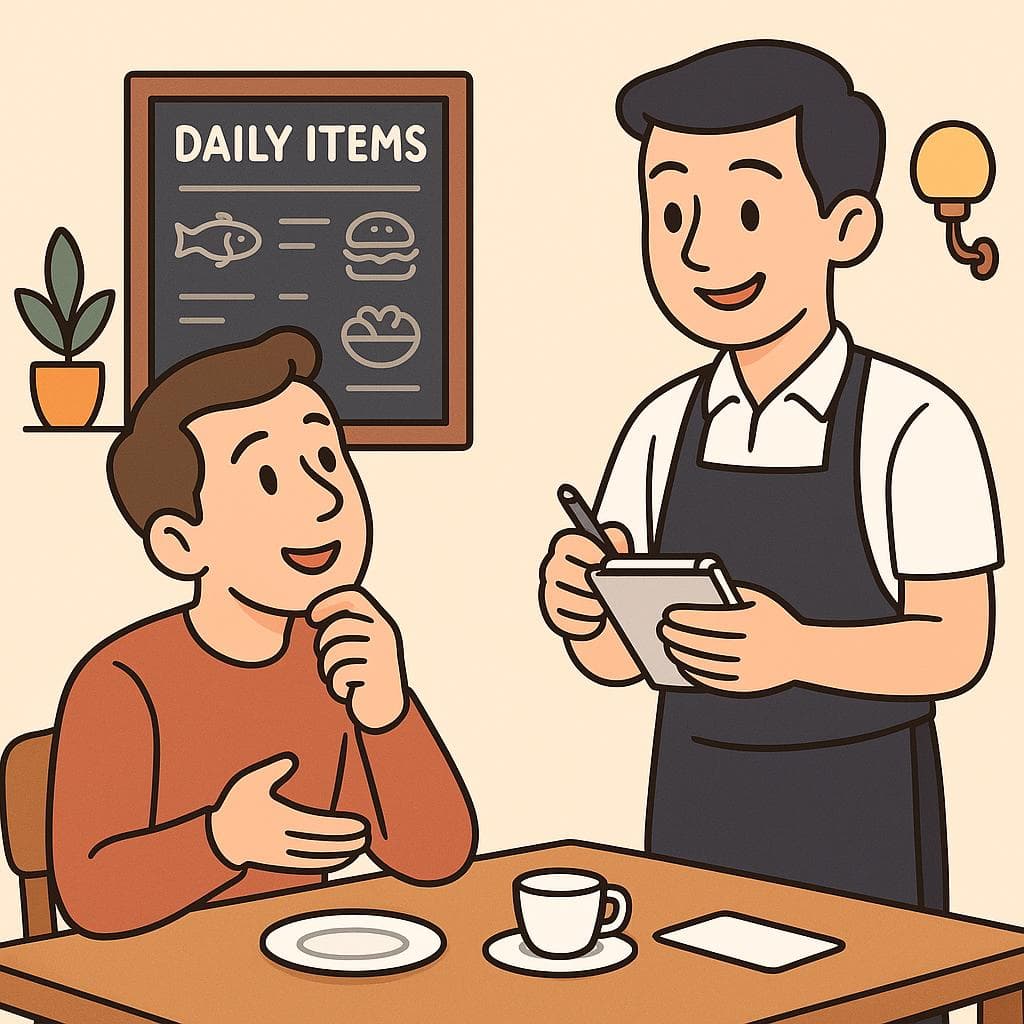What is the special of the day?
in Spanish¿Cuál es el especial del día?
/kwahl ehs el ehs-peh-see-AHL del DEE-ah/
This is the most direct translation. It is widely understood in Latin America when asking for a specific dish that is discounted or featured that day.

Asking the waiter about the 'especial' or 'menú del día' is a great way to eat like a local.
💬Other Ways to Say It
¿Tienen menú del día?
/TYEH-nen meh-NOO del DEE-ah/
In Spain, the 'special' is usually a full 3-course meal for a fixed price. This is the standard way to ask for it.
¿Cuál es el plato del día?
/kwahl ehs el PLAH-toh del DEE-ah/
Literally 'What is the plate of the day?', this focuses on the specific food item rather than a 'deal' or 'discount.'
¿Qué nos recomienda hoy?
/keh nohs reh-koh-MYEN-dah oy/
Meaning 'What do you recommend to us today?', this is a very natural, polite way to find out what is best.
¿Hay alguna sugerencia del chef?
/eye al-GOO-nah soo-heh-REN-see-ah del chef/
Means 'Is there a chef's suggestion?' A slightly fancier way to ask for the special.
¿Qué tienen de comida corrida?
/keh TYEH-nen deh koh-MEE-dah koh-RREE-dah/
Specific to Mexico, 'comida corrida' is the affordable set lunch menu.
🔑Key Words
Key Words to learn:
📊Quick Comparison
Choosing the right phrase depends heavily on where you are and what kind of meal you want.
| Phrase | Region | Best For | Avoid When |
|---|---|---|---|
| ¿Cuál es el especial? | Finding a discounted dish | You are in Spain (use 'Menú del día') | |
| ¿Tienen menú del día? | Full 3-course lunch deal | It is dinner time (noche) | |
| ¿Qué recomienda? | Getting the tastiest food | You are on a strict budget |
📈Difficulty Level
The words are standard, but linking 'Cuál es el' (KWAH-leh-sel) requires a bit of flow.
Simple question structure, just remember to use 'Cuál' instead of 'Qué'.
Knowing the difference between 'special', 'menu', and 'plate of the day' across regions is the tricky part.
Key Challenges:
- Distinguishing between 'la carta' and 'el menú' in Spain
- Understanding the rapid-fire answer from the waiter
💡Examples in Action
Hola, buenas tardes. ¿Cuál es el especial del día?
Hello, good afternoon. What is the special of the day?
Disculpe, ¿hoy tienen menú del día?
Excuse me, do you have a set menu today?
No sé qué pedir. ¿Qué me recomienda?
I don't know what to order. What do you recommend?
🌍Cultural Context
The 'Menú del Día' Phenomenon in Spain
In Spain, the 'special' isn't just one dish—it's a legal institution! The 'menú del día' is a fixed-price lunch that includes a starter (primero), a main course (segundo), drink (bread/wine/water), and dessert or coffee. It's incredibly affordable (usually €10-€15) and is how most locals eat lunch.
Lunch is the Main Event
In almost all Spanish-speaking cultures, 'specials' are geared toward lunch (la comida/el almuerzo), which is the biggest meal of the day, usually eaten between 1:30 PM and 3:30 PM. You rarely find 'specials' at dinner time.
La Comida Corrida in Mexico
Similar to Spain's menu, Mexico has 'comida corrida' (literally 'running food' or fast-moving food). It's a set lunch served in small mom-and-pop places called 'fondas.' If you ask for the 'especial' here, they might look confused; ask what they have for 'comida corrida' instead.
❌ Common Pitfalls
Confusing 'Qué' and 'Cuál'
Mistake: "Saying '¿Qué es el especial?'"
Correction: ¿Cuál es el especial?
The 'Menu' Trap in Spain
Mistake: "Asking for 'el menú' when you want the physical list of food."
Correction: La carta
💡Pro Tips
Look for the Chalkboard
Restaurants often write the daily specials on a chalkboard (pizarra) outside the door or on the wall. If you see 'Hoy tenemos...' (Today we have...), that's your answer before you even ask!
Listen for the List
When you ask this question, the waiter will often recite a fast list of 3-4 items. Don't panic! Just listen for a key ingredient you like (pollo, carne, pescado) or ask them to repeat it slowly: '¿Puede repetir más despacio, por favor?'
🗺️Regional Variations
Spain
The 'menú' is a cultural pillar. It is almost always a multi-course meal. You generally do not tip heavily on a menú del día (maybe leave the small change).
Mexico
In casual fondas, the 'special' usually involves a soup (sopa aguada), rice or pasta (sopa seca), and a main stew (guisado). It's very fast and cheap.
Colombia
The 'corrientazo' is the colloquial term for the standard, affordable lunch plate. 'Almuerzo ejecutivo' implies something slightly nicer but still a set deal.
💬What Comes Next?
The waiter lists the specials and you choose one
Hoy tenemos pollo asado y sopa de lentejas.
Today we have roast chicken and lentil soup.
Me trae el pollo, por favor.
Bring me the chicken, please.
The waiter says there are no specials today
Hoy no tenemos especial.
We don't have a special today.
Entiendo, ¿me permite ver la carta entonces?
I understand, may I see the menu then?
🔄How It Differs from English
In English, a 'special' is often a marketing tactic to sell a specific item. In Spanish-speaking cultures, the daily special (menú del día/comida corrida) is a social utility—a way for workers and locals to get a full, nutritious home-style meal at a low price every day.
False Friends & Common Confusions:
Why it's different: In English, 'menu' is the book you read. In Spain, 'menú' is the food you eat (the set meal).
Use instead: Use 'la carta' for the physical book, and 'el menú' for the set meal deal.
🎯Your Learning Path
➡️ Learn Next:
How to order food in Spanish
Once you know the special, you need to know how to actually order it.
How to ask for the bill in Spanish
Essential for finishing your meal politely.
How to say I am allergic to
Crucial safety vocabulary when asking about specials that might contain hidden ingredients.
✏️Test Your Knowledge
💡 Quick Quiz: What is the special of the day?
Question 1 of 3
You are in Madrid at 2:00 PM and want the cheap, 3-course fixed price meal. What do you ask?
Frequently Asked Questions
Can I ask for the special at dinner time?
Generally, no. The 'menú del día' and 'comida corrida' are lunch-specific traditions (usually 1 PM - 4 PM). At dinner, you typically order à la carte (from the regular menu).
Is the special always the cheapest option?
Usually, yes! It is designed to be the most economical way to eat a full meal. However, 'Sugerencia del chef' (Chef's suggestion) might be a premium, expensive dish, so it's good to check the price.
What if I don't understand the waiter's answer?
This happens to everyone! Waiters often recite specials very fast. It is perfectly polite to say '¿Puede repetirlo más despacio, por favor?' (Can you repeat that slower, please?).
Do I use 'tú' or 'usted' with the waiter?
It depends on the venue. In a casual lunch spot, 'tú' is increasingly common, especially in Spain. In Latin America or nicer restaurants, using 'usted' (formal) is safer and shows respect.
📚Continue Learning Spanish Phrases
Explore More Phrases in These Categories
Find similar phrases to expand your Spanish vocabulary:
Want to Learn More Spanish Phrases?
Browse our complete collection of Spanish phrases organized by situation, from basic greetings to advanced conversations. Perfect for travelers, students, and anyone learning Spanish.
View All Spanish Phrases →